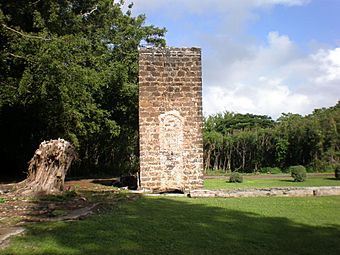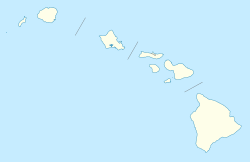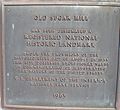Old Sugar Mill of Koloa facts for kids
|
Old Sugar Mill of Kōloa
|
|

Brick chimney of Old Sugar Mill
|
|
| Location | Maluhia and Kōloa Roads, Kōloa |
|---|---|
| Built | 1839–1841 |
| NRHP reference No. | 66000296 |
Quick facts for kids Significant dates |
|
| Added to NRHP | October 15, 1966 |
| Designated NHL | December 29, 1962 |
The Old Sugar Mill of Kōloa was a very important place in Hawaii's history. It was part of the first successful sugarcane farm, called a plantation, in Hawaii. This plantation started in Kōloa on the island of Kauai in 1835. It was founded by a company called Ladd & Company.
This sugar mill marked the beginning of Hawaii's biggest industry: sugar production. The old building was recognized as a National Historic Landmark on December 29, 1962. Today, you can still see a stone chimney and parts of the original foundations from 1840.
Contents
How Sugar Farming Began
Even though ancient Hawaiians grew small amounts of sugarcane, the Kōloa plantation was the first to grow it on a very large scale for business. Missionaries like Joseph Goodrich and Samuel Ruggles had tried growing crops to help their missions and give jobs to their students.
The plantation was built in Kōloa for good reasons. The soil was very fertile, meaning it was great for growing crops. It was also close to a good port, which made it easy to ship sugar. Plus, it was near the Maulili pool, which had a waterfall. This waterfall provided power for the sugar processing machines.
Getting the land for the plantation was not easy. The founders of Ladd & Co. were William Ladd, Peter A. Brinsmade, and William Northey Hooper. The Hawaiians did not want to lease their land at first. They even refused to sell food to the plantation managers. Over time, the two groups formed a difficult partnership, which led to many disagreements.
Growing the Plantation
Ladd & Co. leased about 980 acres of land from King Kamehameha III. But in September 1835, they only planted 12 acres of sugarcane. A small mill, powered by water from the Maulili pool, made a small amount of molasses in 1836. The first wooden rollers in the mill wore out quickly. So, they were replaced with stronger iron ones to make more sugar. By 1837, the mill produced over 4,000 pounds of sugar and 700 gallons of molasses.
A new, larger mill was built from 1839 to 1841. Its chimney and foundations are still standing today. This new mill was built near Waihohonu Stream and cost about $16,000 to construct.
Challenges with Workers
The managers of the sugar plantation faced many problems with their Hawaiian workers. They felt the workers were not doing enough. They believed that Hawaiian culture made it hard for workers to understand their duties to the plantation owners. One manager even claimed that 10 white men could do the work of 400 Hawaiians.
Plantation owners paid workers $2 per month. This pay was given in "Kauai Currency," which could only be used at stores owned by the plantation. Goods at these stores were sold at slightly higher prices. Workers were given furnished houses but had to pay a small daily fee for them.
In 1841, Hawaiian workers went on strike because they wanted higher wages. However, their strike was not successful. These difficult working conditions led plantation owners to look for workers from other countries. This brought many new people to the Hawaiian islands from all over the world.
The Kōloa plantation used a special contract system. This system gave workers a small share in the crop. But it also stopped them from leaving to find other jobs without facing penalties. Other sugar planters in Hawaii later adopted these methods. These powerful companies became known as the "Big Five".
The End of an Era
Ladd & Co. closed down in 1844. This happened after they failed in their plan to start plantations on other Hawaiian islands. The Hawaiian government took back the Kōloa plantation. They then sold it to Dr. Robert Wood, who ran it until 1874.
In 1853, a steam engine was used for the first time in a Hawaiian sugar mill. This new technology helped power the mill. Samuel Burbank also created a special deep plow to help grow more sugarcane.
The Koloa Agricultural Company was bought by the Duncan McBryde family in 1899. They added it to their other land and the Eleʻele Plantation. Later, in 1910, Alexander & Baldwin became the company's agent. They eventually bought out the other partners.
The old mill was replaced by a much larger one in 1912. This new mill was located to the east of the old one. The Kōloa plantation finally shut down in 1996. In 2000, Grove Farm, which owned the plantation, was sold to Steve Case. His grandfather had worked on the plantation.
Gallery
See also
 In Spanish: Antiguo trapiche de azúcar de Koloa para niños
In Spanish: Antiguo trapiche de azúcar de Koloa para niños






